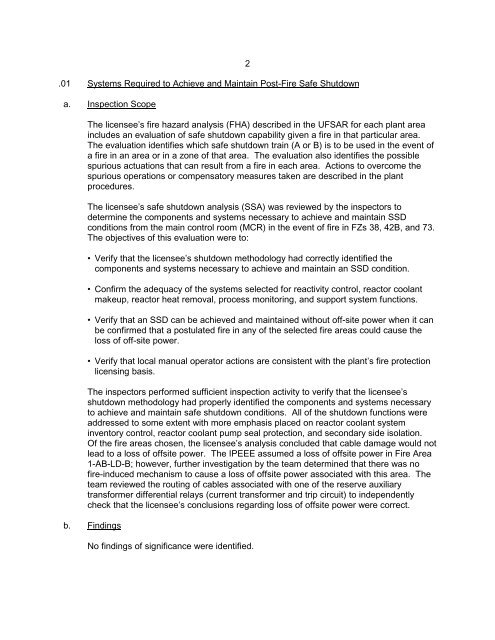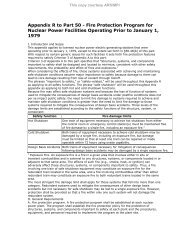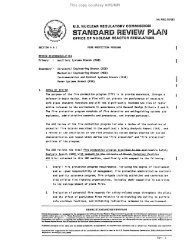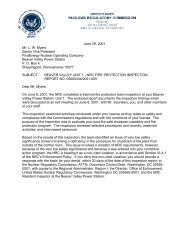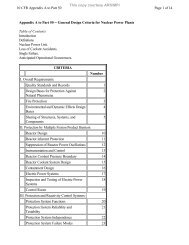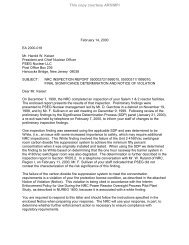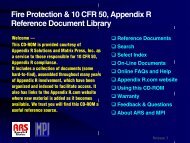Vogtle - AppendixR.com
Vogtle - AppendixR.com
Vogtle - AppendixR.com
You also want an ePaper? Increase the reach of your titles
YUMPU automatically turns print PDFs into web optimized ePapers that Google loves.
.01 Systems Required to Achieve and Maintain Post-Fire Safe Shutdown<br />
a. Inspection Scope<br />
2<br />
The licensee’s fire hazard analysis (FHA) described in the UFSAR for each plant area<br />
includes an evaluation of safe shutdown capability given a fire in that particular area.<br />
The evaluation identifies which safe shutdown train (A or B) is to be used in the event of<br />
a fire in an area or in a zone of that area. The evaluation also identifies the possible<br />
spurious actuations that can result from a fire in each area. Actions to over<strong>com</strong>e the<br />
spurious operations or <strong>com</strong>pensatory measures taken are described in the plant<br />
procedures.<br />
The licensee’s safe shutdown analysis (SSA) was reviewed by the inspectors to<br />
determine the <strong>com</strong>ponents and systems necessary to achieve and maintain SSD<br />
conditions from the main control room (MCR) in the event of fire in FZs 38, 42B, and 73.<br />
The objectives of this evaluation were to:<br />
• Verify that the licensee’s shutdown methodology had correctly identified the<br />
<strong>com</strong>ponents and systems necessary to achieve and maintain an SSD condition.<br />
• Confirm the adequacy of the systems selected for reactivity control, reactor coolant<br />
makeup, reactor heat removal, process monitoring, and support system functions.<br />
• Verify that an SSD can be achieved and maintained without off-site power when it can<br />
be confirmed that a postulated fire in any of the selected fire areas could cause the<br />
loss of off-site power.<br />
• Verify that local manual operator actions are consistent with the plant’s fire protection<br />
licensing basis.<br />
The inspectors performed sufficient inspection activity to verify that the licensee’s<br />
shutdown methodology had properly identified the <strong>com</strong>ponents and systems necessary<br />
to achieve and maintain safe shutdown conditions. All of the shutdown functions were<br />
addressed to some extent with more emphasis placed on reactor coolant system<br />
inventory control, reactor coolant pump seal protection, and secondary side isolation.<br />
Of the fire areas chosen, the licensee’s analysis concluded that cable damage would not<br />
lead to a loss of offsite power. The IPEEE assumed a loss of offsite power in Fire Area<br />
1-AB-LD-B; however, further investigation by the team determined that there was no<br />
fire-induced mechanism to cause a loss of offsite power associated with this area. The<br />
team reviewed the routing of cables associated with one of the reserve auxiliary<br />
transformer differential relays (current transformer and trip circuit) to independently<br />
check that the licensee’s conclusions regarding loss of offsite power were correct.<br />
b. Findings<br />
No findings of significance were identified.


